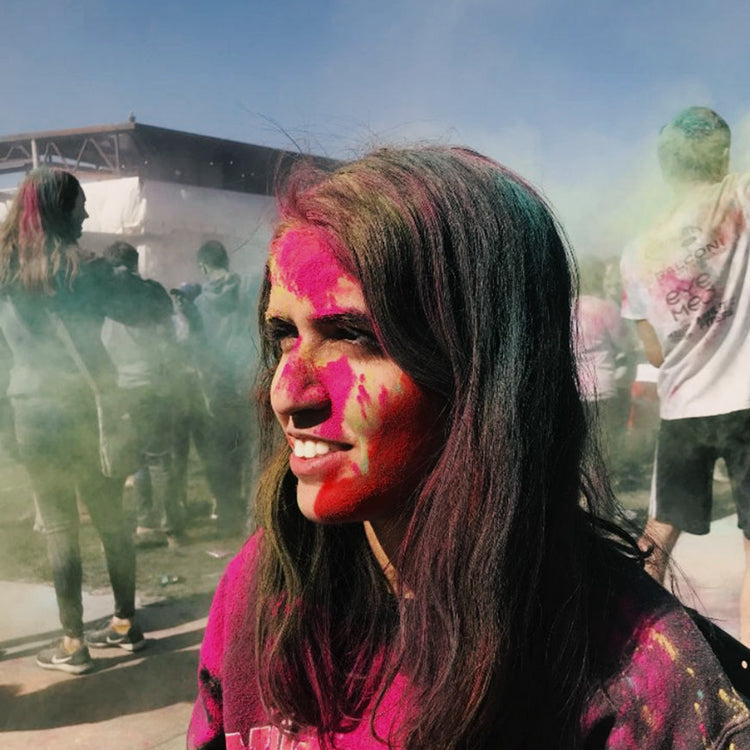



What initially drew you to art?
When I was five-years old, I moved from India to the United States. Moving here was a big culture shock and there was initially a language barrier also. I remember taking my first art class in kindergarten and absolutely loving it. From there on out, I would draw on everything I could get my hands on from napkins to the sidewalk. Art was something that I could do without having to worry about being right or wrong. Over the years I’ve expanded the ways I can be creative and my love for art has only grown.
You’re an Interaction & Communication Design student, what does that mean?
Communication design is problem solving that aims to inform, persuade, educate and/or entertain through the usage of design. So essentially, it’s looking at the ways we can improve communication in the world around us by combining functionality and aesthetics. This work includes things like information architecture, web design, illustration, typography, advertising, and user experience. In my program, we opportunities to develop specific areas of interest in either print, motion or interaction. Interaction design is the communication between a person and a product, system or service. Often times it’s more digital and web based.
What is it about digital art that interests you?
The biggest thing that interests me about digital art is the fact that it’s very flexible. Once you have access to the basic tools that are needed, it becomes very convenient and you have the option to do it from almost anywhere. There isn’t a fear of running out of supplies or worrying about messing things up. In digital art, you can undo things, rearrange layers, erase, experiment with new tools and easily share your work with others.
Do you think a balance of hands-on art and digital art helps you? In what ways?
I believe for me personally, having a balance of hands-on art and digital art is integral to being a designer. On the computer, you get held up on things like alignment, exact spacing, type choice and end up being more focused on the small details. These details are important, but sometimes distract you from the overall message that you are trying to communicate with your design. Which is why I find it easier to do some hands-on sketching first so I have a clear idea of what I want to do and plan out my designs. Sketching also allows me to brainstorm and ideate a lot faster because I’m not limited by the straight lines and tools of the computer. Once I’m pleased with my sketches and have an idea of what I intend to do, I bring them to life digitally where I can pay more close attention to all the components of my design.
What are you hoping to get out of inktober?
In the past, I’ve tried to do inktober and usually ended up doing a few days here and there. This year I hope to participate in it throughout the entire month and post my drawings to instagram as a way to hold myself accountable and make sure I do them. I also hope to meet other creatives who are participating in inktober and see all the wonderful work they are making.
Do you have any words of wisdom for the busy artist trying to make art in their free time?
Just a little bit each day goes a long way. If you don’t have a lot of free time, try starting off with about 15 minutes each day. This practice every day will add up, and you can commit more time on days when you have more free time. Additionally, take a small sketchbook with you everywhere you go. That way when you are waiting for something, or have a few minutes to spare, you can take it out and make something.
What’s you favorite Pentalic product and why?
My favorite Pentalic product is the Art Traveler Pocket Journal Sketch Book. I have it in the size 8” x6” and it’s the perfect size to always have on me. I use it for sketching, lettering, taking down quick notes and even gouache!
Any advice for someone interested in pursuing a creative field?
Practice makes progress. I feel that sometimes people don’t start to do things because they see all the amazing things that other people are doing and get discouraged that they won’t ever be that good. However, that persons work hasn’t always looked like that and it has taken them a lot of practice to get where they are now. Everyone starts somewhere and we shouldn’t compare our beginning to another persons middle. Instead, constantly practice what you’re doing and create a much as you can, so that you learn new things along the way and see progress in your work.
To learn more about Babaljit Kaur, checkout her Instagram @_babaljitkaur and website at http://babaljitkaur.com/.

